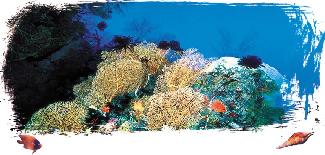
6th August 2000
Front Page|
News/Comment|
Editorial/Opinion| Business|
Sports|
Sports Plus| Mirror Magazine

![]()
That wondrous beauty close up
Dr. Sanjiva Wijesingha discovers the spectacular underwater world of the Great barrier Reef
It was my enthusiastic Bi-ology teacher Brookie D' Silva who first fired my imagination with his descriptions of the Great Barrier Reef.
That was a long time ago - when we were just commencing our 0/Level
year at S. Thomas. Often described as the eighth natural wonder of the
world, the Reef, with an area of 134,600 square miles, is more than five
times the size of our own country. It is said to be the only living thing
that can be  seen
from outer space.
seen
from outer space.
Home to a variety of plants and animals - from microscopic plankton to large humpback whales - it extends for over 2500 kilometres off the east coast of Australia's northernmost state Queensland. It is truly a habitat for creatures great and small.
My schoolboy ambition to visit the Reef, kindled by Brookie over thirty-five years ago, was fulfilled when my wife and I recently made a trip to Port Douglas - a town in the far north of Queensland. Most companies that organise boat trips out to the Reef are based either in Port Douglas or Cairns (an hour's drive south of Port).
The city of Cairns, where the international airport is situated, has an unusual Sri Lankan connection - it is named after William Wellington Cairns, the first British Governor of Queensland who, prior to his appointment as Governor there in 1875 was the Postmaster General of Ceylon!
Port Douglas with its warm tropical weather is very much like Sri Lanka. Coconut palms, plantain trees, sugarcane and even Araliya and Kottang trees flourish in this part of Australia.
The Great Barrier Reef is not a continuous coral structure along the Australian coast - it is made up of nearly 3000 individual reefs that are separated from the mainland by a well protected channel used by coastal shipping.
Our trip out to the Reef was in the company of a couple of hundred other tourists in a high speed motor boat, which took us in a little over an hour across the channel to a spot called Agincourt Reef on the edge of the continental shelf. Here the water is shallow enough so that you can see the bottom if you dip your head beneath the surface. You can either ride the glass bottomed submarine or get in the water yourself - both methods give you a beautiful opportunity to view the Reef and its myriad marine citizens.
I had never snorkelled before but this was no barrier. The tour company provides all those on board its vessel with the necessary gear - a close fitting mask to cover eyes and nose, a pair of rubber flippers for the feet and a snorkel to breathe through. This last item is a J-shaped tube one end of which projects above the water when you float face down just beneath the water's surface. Getting used to breathing through the snorkel can be bit tricky at the start - but you soon learn the technique. Even people who wear bothal adi glasses like myself are provided with masks that have spectacle lenses incorporated in the glass - so when they put the mask on they can see clearly underwater. For me this was a pleasant contrast to my usual semi-blind state when I go swimming without my spectacles!
Off Agincourt Reef the sea is as clear and shallow as in a swimming pool. You can snorkel and float above a forest of coral a few metres beneath the surface - and you soon discover sights and sensations as if you were visiting another world. Small clown fish dart about as bigger parrot fish graze on the coral. Large clams with velvet lips close their "mouths" as you swim by. It is a veritable wonderland of vividly coloured fish, sea anemones, starfish and nature's own sculptures of coral formations.
You can certainly touch the corals - although you are advised not to, as they are formed of living organisms. Astronauts have described the Reef as looking like "a thin line on the blue surface of the sea" when viewed from outer space.
Thankfully for us, we were able to see this wondrous beauty close up - truly one of the world's natural wonders.








![]()
Front Page| News/Comment| Editorial/Opinion| Plus| Business| Sports| Sports Plus| Mirror Magazine
Please send your comments and suggestions on this web site to

